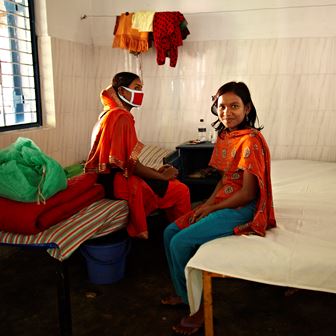Shorter treatment for tuberculosis improves success rate
29 October 2014
Ten years of collaboration between the Damien Foundation Belgium and the Institute of Tropical Medicine in Antwerp (ITM) has produced a new treatment that could revolutionise global tuberculosis control.
Currently, the most dangerous threat to global tuberculosis control is the increasing epidemic of multidrug-resistant tuberculosis (MDR-TB). Treatment of this serious condition is difficult due to the treatment length and the toxicity of second-line drugs. During the past decade, ITM has researched a shorter, less-toxic treatment regimen, with the support of the Damien Foundation. The treatment will potentially revolutionize the global management of this condition.

Patients in The Damien Foundation's Bangladesh
clinic
In what has become known as the Bangladesh regimen, ITM’s Armand Van Deun and colleagues developed a treatment that takes only 9 months. This regimen replaces the currently recommended treatment of 18 to 24 months. In 2010, the researchers reported that this treatment increased the success rate from 65% to 88% for MDR-TB patients in Bangladesh. The treatment is based on a combination of existing drugs.
The researchers confirm the results in this month’s International Journal of Tuberculosis and Lung Disease. The figures regarding over 500 patients have only marginally deteriorated with respect to their 2010 study on 200 patients. The researchers report a favourable outcome in roughly 85% of cases, in spite of increasing levels of serious second-line drug resistance. A smaller study in Niger confirmed the outstanding results of the shorter treatment.
In all the studies with the Bangladesh regimen, patients were provided both the treatment and intensive socioeconomic support by the Damien Foundation to enhance adherence to treatment.
“The Bangladesh regimen shows that multi-resistant tuberculosis can now be cured, especially when good socio-economic support is given to patients. We can avoid resistance if we optimally combine available medicines and if these principles are respected in TB control programmes worldwide. It also means that new drugs that are in the pipeline can have a longer life span,” said Prof. Dr Bouke de Jong, Head of the Mycobacteriology unit at ITM.
The lifesaving regimen is currently being tested in the STREAM study, a formal clinical trial in South Africa, Ethiopia and Vietnam, including countries with higher rates of HIV co-infection compared to Bangladesh.
About the collaboration
The collaboration between the Damien Foundation, which celebrates its 50th anniversary this year, and ITM has resulted in several important breakthroughs. These include global guidelines for tuberculosis smear microscopy and the fact that high quality standards for smear microscopy in laboratories can now be assured throughout the developing world.
The two organisations play an important role in global efforts to control TB under the coordination by the WHO. The Damien Foundation and ITM join hands against tuberculosis in Bangladesh, Burundi, the Democratic Republic of the Congo, Niger, Nigeria and Rwanda.
Worldwide, 9 million people develop tuberculosis annually and 2 million do not survive the infection caused by the mycobacterium M. tuberculosis. Sixty percent of all new TB cases occur in Asia, while Africa has the highest rates of new TB patients per inhabitant.
Further information
Foundation Damien: www.damiaanactie.info/damienfoundation/home2.html